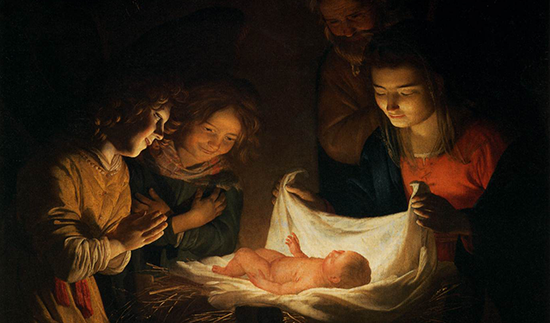
December-January 2014
Roots: Growing
Deeper in Faith
------------------
|

About the Artwork: Painted by Dutch Master Gerard Van Honthorst in the 15th century.
intersect, where the bible meets life
The Promise of His Coming...Twice
Since it’s the season, let’s talk about the coming of Jesus. But which one, you say. That’s a great question and raises some crucial points. Though separated by different purposes and a length of time unknown to us, His two comings are inseparably linked. For instance, angels play a prominent role in both advents (Luke 2:13; 2 Thessalonians 1:7). Then there’s the worship aspect seen in both (Matthew 2:2, 8; Revelation 19). Two mentions of a star link the two as well (Matthew 2:2; 2 Peter 1:19). We even know what the Lord is wearing both times (Luke 2:7, 12; Revelation 19:12-16).
Yet the contrasts between Christ’s first and second appearances also stand out. He came the first time humbly, meekly; when He returns, it will be in glory and in triumph. The New Testament begins and ends with the coming of Jesus. In Matthew 1:1, He is “Jesus Christ,” Jesus Messiah, the Anointed One come to begin a mission. In Revelation 22:20, He is “Lord Jesus,” kyrie ‘I?sou, the Sovereign One come again to complete that mission.
So What’s Wrong?
Understand that I embrace these scriptural truths with glad faith. But I am uneasy about Christ’s return. Not with Him and His promised coming, but with my own heart’s attitude about the whole event. My disquiet stems from my own mixed feelings, feelings that I suspect mirror the way the Church at large feels.
Have we—have I—become so culture-soaked, so much at home in the world that the thought of leaving this place disturbs me, even repels me, though it means leaving to be with Christ in the most perfect place possible suited just for us? Are we so crystallized in our on-screen, specially effected media modes of an entertainment-driven lifestyle that the reality of the second coming and the real person at its center take on for us the semblance of nothing more than a trailer for another superhero movie? Are we numb in our de facto denial of Jesus’ return? Is it just another unit of Sunday School curriculum we acknowledge and affirm without affecting how we live?
Scripture offers a better alternative. Christ’s return is:
-
A catalyst for spiritual growth (2 Thessalonians 1:3-4).
-
A motivator for good works (2 Thessalonians 2:17).
-
A propellant for reaching people with the gospel (2 Thessalonians 1:8-9).
-
An opportunity for believers to live faithfully in the meantime (2 Thessalonians 1:4; 3:3-4).
-
A prompt to appreciate fellow Christians (2 Thessalonians 1:3-4).
-
An incentive to final hope (1 Thessalonians 4:13; 5:11).
Maranatha—The Last Word
Early Christians treasured this hope in the Lord’s return by greeting each other with the word maranatha. Paul used it to close First Corinthians (16:22)—ironically, a letter to a troubled church desperately needing a final word of hope. Though this Aramaic word is really a phrase, scholars debate whether it means, “Our Lord has come” (declaring His first advent) or, “Come, O Lord” (requesting His second advent).
I cast my vote with the latter view as reflected in the comments of the great French biblicist F. L. Godet. He offers a curious idea about Paul’s use of maranatha here. “Could it be,” he mused, “that as the apostle closed the letter with his own signature (16:21), he also, as was customary, pressed his personal seal on the wax lock? And since those who copied the letter could not reproduce the seal itself, they simply transcribed the word on the seal, the word maranatha.” Paul’s last words, if Godet is right, served as an enduring reminder to the Church and as an earnest prayer to Christ—the same words that conclude the Bible itself.
I suspect the Magi prayed the same prayer some 21 centuries ago. I know we should, too.
Someone’s Coming!
For me, the maranatha hope comes to life in a family incident many decades ago. In 1944, my Uncle Cairwell’s bomber was shot down over East Prussia. For many months, my grandmother and her family had no idea what had become of her oldest son, my mother’s brother. Only later did a few censored letters get through to them from his POW camp in Germany. They gave no hope, however, that he would return home soon or ever.
Several months later, on a hot summer afternoon, as my grandmother, grandfather, and their seven children tended to their large East Tennessee garden, a cloud of dust rose up on the rough country road toward the crest of the hill. Before anyone else knew what was happening, my grandmother dropped her hoe, threw off her apron, and sprinted (as best she could) toward the road. Sure enough, her instincts had told her that this car, this arrival, was special—that this was her eldest boy, the POW, coming home. And she was right! The taxi from Knoxville crunched to a stop, and those hills and pastures had a front row seat to a wonderful reunion.
A precious one had returned.
Intersect: Where the Bible Meets Life is a regular column written by Dr. Garnett Reid, a member of the Bible faculty at Welch College. Visit his blog: www.garnettreid.com.
|
|

